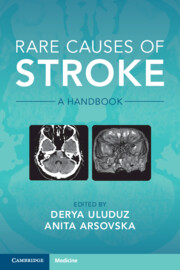Book contents
- Rare Causes of Stroke
- Rare Causes of Stroke
- Copyright page
- Contents
- Contributors
- Preface
- 1 Inflammatory Conditions
- 2 Infectious and Postinfectious Vasculitis
- 3 Hypercoagulable Causes of Stroke
- 4 Drug-Related Stroke
- 5 Hereditary and Genetic Causes of Stroke
- 6 Rare Causes of Cardioembolism
- Chapter 6.1 Paradoxical Embolism: Patent Foramen Ovale
- Chapter 6.2 Infective Endocarditis
- 7 Vasospastic Conditions and Other Vasculopathies
- 8 Other Non-inflammatory Vasculopathies
- 9 Venous Occlusive Conditions
- 10 Bone Disorders and Stroke
- Index
- References
Chapter 6.1 - Paradoxical Embolism: Patent Foramen Ovale
from 6 - Rare Causes of Cardioembolism
Published online by Cambridge University Press: 06 October 2022
- Rare Causes of Stroke
- Rare Causes of Stroke
- Copyright page
- Contents
- Contributors
- Preface
- 1 Inflammatory Conditions
- 2 Infectious and Postinfectious Vasculitis
- 3 Hypercoagulable Causes of Stroke
- 4 Drug-Related Stroke
- 5 Hereditary and Genetic Causes of Stroke
- 6 Rare Causes of Cardioembolism
- Chapter 6.1 Paradoxical Embolism: Patent Foramen Ovale
- Chapter 6.2 Infective Endocarditis
- 7 Vasospastic Conditions and Other Vasculopathies
- 8 Other Non-inflammatory Vasculopathies
- 9 Venous Occlusive Conditions
- 10 Bone Disorders and Stroke
- Index
- References
Summary
The role of a PFO as a risk factor for ischemic stroke has been established in recent years, particularly for strokes that lack an apparent cause (cryptogenic). Approximately 25% of the general population has a PFO, and it has not been shown to increase the risk of ischemic stroke. On the other hand, the prevalence of PFO is significantly higher in patients with cryptogenic stroke; up to 40% of ischemic cryptogenic strokes have a PFO, suggesting that paradoxical embolism through a PFO may be associated in a number of cryptogenic strokes.We present a 62 year-old female with ischemic stroke and PFO
Keywords
- Type
- Chapter
- Information
- Rare Causes of StrokeA Handbook, pp. 281 - 286Publisher: Cambridge University PressPrint publication year: 2022



